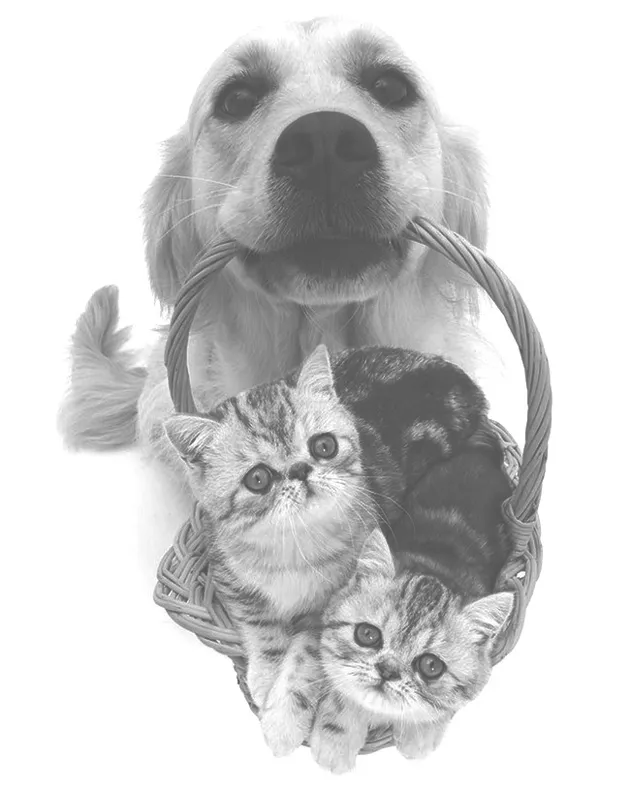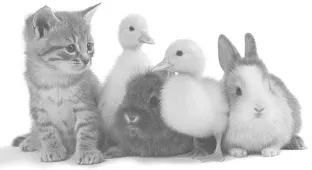宠物文化
2017-07-25詹娜古德罗王丹怡
文/詹娜·古德罗 译/王丹怡
宠物文化
文/詹娜·古德罗 译/王丹怡
Charlotte Reed is a pet expert by profession1by profession 以……为业。and says she likes to be a “living example” for her clients.She and her husband have two cats and four dogs in their downtown Manhattan apartment, and she beams when they’re complimented on their appearance or manners. “I’m a proud mother,” she says.
[2] The couple has no children, although each dog has been appointed a godmother and pictures of the “babies”are displayed in every corner of the house. The animals eat as well as their owners, including homemade treats and meals to ensure well-balanced diets.“They have rotating fish, chicken and meat,” she says.
[3] All four dogs sleep in the couple’s full-size bed, packing in2pack in 堆满;挤满。between Charlotte and her husband. Vacations are spent on the river rather than the ocean,which might prove too dangerous for the dogs. Even so, as a precaution, each dog dons a life preserver. For birthdays the pets receive presents and a card,which usually reads “Happy Birthday!Love, Mommy and Daddy” and is signed by the siblings.
[4] Reed is not alone in considering her animals to be part of the family.America’s cultural pendulum has swung toward pets. According to the American Pet Products Association (APPA),a trade group, nearly three-quarters of U.S. households own pets, and most are willing to spend vast amounts of time and money to keep Sparky and Fluffy3sparky本意为活泼的、充满活力的,也是很多影视、漫画中动物的名字,如电影《科学怪狗》中主人公维克托(Victor)的狗就叫Sparky。fluffy意为松软的、蓬松的,也多见于动物名字。这两个词在这里泛指宠物。happy. The pet industry has tripled in the past 15 years.
[5] In the last few years, they’ve exploded into popular culture, too. As Paris Hilton4美国模特、演员、歌手、作家、商人,希尔顿集团继承人。养有很多宠物狗,曾与它们一起为很多品牌拍摄过广告。and Jessica Simpson5美国流行歌手,影视演员。are splashed across the celebrity glossies with their furry friends, the broader media followed suit6follow suit照着做,仿效。. People.com offers the offshoot People Pets.com, AOL draws audiences with its new site Paw NNaa--tion, and icanhascheezburger.com gets hundreds of submissions daily of usergenerated lol cats (laugh-out-loud funny photos of cats).
[6] “People are fascinated by pets. We act and spend on them as if they were our children,” says NYU7= New York University纽约大学。sociology professor Colin Jerolmack, who studies animals in society. “We’ve civilized them to the point that they are no longer a part of wild nature.” It wasn’t always so. In the 1800s it was very rare to have a pet, Jerolmack says. They were luxury items and status symbols of the bourgeoisie, showcasing that a family had the means and resources to own a pet.Animals then were purely functional;dogs were often used to hunt, and cats used to scare off mice. As society developed and technology advanced, the utilitarian use of pets waned.
[7] Darwin’s speculations, too,brought to popular attention that animals might have selves and emotions similar to humans. Now, they are a middle class commodity that everyone wants. This trend is international: According to a CBS8= Columbia Broadcasting System(美国)哥伦比亚广播公司。News report, there are now more pet dogs and cats—23 million—in Japan than there are children under 15. Alan Siskind is the publisher of the online magazine Dog News Daily. People are increasingly kissing their dogs, he says, so they stock up on9stock up on大量贮备,囤积。the doggie mouthwash. Owners are sleeping with their animals more, so they invest in good flea medications,too. Siskind believes that we’ve humanized them to the point that we want them to have the same food, clothes,beds and even health care as us.
[8] According to APPA, women are the primary pet shoppers, leading 80%of pet spending. Now that pets have become an integral part of the family,Siskind says, women’s pet spending reflects their “role as the primary care provider, nurturer and shopper for the human members of the household.” He believes that pets are beginning to take a central role in many women’s lives.It’s now more common for women to be single and live longer, or to have delayed or abstained from10abstain from戒绝,抑制。having children or to be working from home.A pet serves as a companion and object of their affection. “Dogs are the fourlegged child,” says Siskind, and we’re pampering them like never before.
[9] On the market now for pets are braces, orthopedic beds, strollers, car seats, electric toothbrushes and fashion ensembles from faux-mink coats to jewelry and leather jackets. And just for kicks, owners can splurge on11splurge on挥霍。feline spas, dog massages, pet toy gyms, doggie hotels with HD12= High Definition(电视、电影或录像图像)高清晰度,高画质。television and a fl ight on Pet Airways, a new airline devoted to furry “pawsengers13pawsenger化用passenger,指有爪的乘客,即那些宠物乘客。.”
[10] Wendy Diamond, editor of Animal Fair magazine and author of the upcoming It’s a Dog’s World, believes the trend will only continue to compound. With growing awareness about adoption and the positive health bene fi ts of owning pets—including reducing stress and depression—more people will continue to treat them like extensions of their human selves. Diamond’s observed the transformation in the past decade. “Ten years ago, they were in the doghouse,” she says. “Now they’re on silk dog beds or in your bed.” But these considerations may not always be good for the animal.
[11] Author of Understanding Dogs,sociologist Clinton Sanders, says pet obsession has been rapidly growing during the past 20 years. “The danger is that we don’t let animals be animals anymore,” he says. “It does them a disservice and results in some ignorant kinds of treatment.”
[12] “Dogs,” he says, “would be perfectly content eating the same food every day for the rest of their lives. A dog’s owner, on the other hand, might say, ‘I would never want the same meal again and again, how boring.’ Then she goes to the store and buys her pup a variety of options, which in turn disrupts the dog’s digestive tract.” But, Sanders insists, “Dogs aren’t like us.”
[13] Similarly, interpreting their behavior as if they were human can lead to false assumptions. Says Sanders,“People might believe the dog peed on their bed because she was angry that they were gone, but what if the dog has a urinary tract infection? It’s an inappropriate way of understanding their behavior.”
[14] Why have they become so important to us? NYU’s Jerolmack speculates that it may be due to people’s decreasing connection to each other. In an era of online social networks, long work hours and distances between families,we have far fewer strong social ties and many more weak ties, he says. “We’re spending a lot more time alone or with our immediate family14immediate family 直系亲属,近亲,直接家庭成员。. The companionship of pets has become much more valuable today.”
[15] Furthermore, relationships with pets are much less emotionally messy.They love you no matter what you look like or if your breath stinks. And they show affection consistently. Pets have become a relatively easy and loveable replacement of children or a strong community, which, Jerolmack warns,may lead to an impending culture clash.
[16] “In the city, we’re already seeing debates over park space going to kids or dogs,” says Jerolmack. “There will be more people demanding social recognition of pets, wanting to bring their pets everywhere. And with an industry relying on them, I don’t see us going backwards.”■
夏洛特·里德是一名宠物专家,她说她喜欢做客户们的活榜样。她和丈夫在曼哈顿市中心的公寓里养有两只猫和四只狗。每当有人夸它们长得可爱或乖巧听话的时候,她都会开心地笑。她说:“我是一名自豪的母亲。”
[2]里德夫妇没有孩子,但是他们的每只狗都认了一名教母,这些狗宝宝的照片在屋里随处可见。它们吃的和主人一样,包括家里自制的点心和食物,来确保它们均衡饮食。夏洛特说:“我们给它们吃鱼、鸡和其他肉类,轮换着来。”
[3]四只狗都睡在这对夫妻的大床上,挤在夏洛特和她丈夫之间。度假时他们会去河边,而不是海滨,因为海对狗狗们来说太危险了。即便去河边,为了预防意外,每只狗还是会穿救生衣。过生日时它们都会收到礼物和贺卡,卡片上通常写着“生日快乐!爱你的爸爸妈妈”,其他的“兄弟姐妹”也都会在上面按爪签名。
[4]像里德这样把宠物当作家庭一员的人还有很多。美国文化的钟摆已偏向宠物。据一家商业集团——美国宠物产品协会(APPA)——统计,有近3/4的美国家庭养宠物,大多数都愿意花大把的时间和金钱来让这些毛茸茸的小家伙们开心快乐。宠物产业在过去的15年里增长了两倍。
[5]在过去的几年中,养宠物也迅速成为一种流行文化。当帕丽斯·希尔顿和杰西卡·辛普森带着她们毛茸茸的小伙伴们横扫多家名人杂志后,更多媒体开始跟风效仿。美国《人物》杂志官网建立了一个以宠物内容为主的分支网站People Pets.com,美国在线(AOL)则通过新网站萌爪王国(Paw Nation)来吸引读者,网站icanhascheezburger.com每天都会收到成百上千张用户自己生成的搞笑猫咪图片。
[6]科林·杰罗马克是纽约大学的社会学教授,他专门研究社会环境下的动物。他说:“人们都迷上了宠物,把它们当作自己的孩子来对待、为它们大把花钱。我们驯化了它们,使之不再具有野性。”但在过去,情况却并非如此。在19世纪,养宠物都是很少见的,杰罗马克说道。当时宠物是一种奢侈品,是资产阶级地位的象征,可以显示宠物的主人有财力和资源来供养它们。那时候饲养的动物基本都是有实际用途的,狗常用来打猎,猫用来吓跑老鼠。随着社会发展和技术进步,宠物的实用功能就逐渐减弱了。

[7]达尔文的理论也使人们更广泛注意到动物可能有与人类相似的自我意识和情感。现在,它们成为了一种人人都想要的中产阶级商品。这一趋势在全球蔓延:根据美国哥伦比亚广播公司新闻网的报道,日本现在有2300万只宠物猫狗,比日本15岁以下的儿童还要多。艾伦·西斯金德是网络杂志《狗狗新闻日报》的出版人,他说,人们越来越多地亲吻自己的宠物狗,因此会囤很多狗狗漱口水。主人和宠物一起睡的时候更多了,所以他们也会买高效的除蚤药。西斯金德认为我们给宠物赋予了太多人的特性,想要它们和我们吃一样的食物,穿一样的衣服,睡同样的床,甚至和我们享受一样的医疗服务。
[8]美国宠物产品协会发现,宠物产品的购买者主要是女性,她们贡献了80%的宠物消费。西斯金德说,宠物已经成为家庭生活中不可或缺的一部分,女性在宠物产品上的消费反映出她们“是家庭成员主要的护理者、养育者和采购者”。他相信宠物已经开始成为许多女性生活的中心。现在,女性单身越来越普遍,寿命也普遍更长,更多女性选择推迟生育或者不要小孩,在家工作的女性也越来越多。宠物陪伴着她们,同时也是她们寄托感情的对象。西斯金德说:“狗狗就是四条腿的小孩。”人类如此宠爱动物的情况前所未有。
[9]市面上现在有宠物专用的腿部支架、矫形床、手推车、汽车安全座椅、电动牙刷以及各类时尚用品,从人造貂皮大衣、珠宝饰品到皮夹克,应有尽有。只是出于娱乐,主人们还会花钱给猫做水疗,给狗狗按摩,带它们去宠物玩具健身房,让它们住有高清电视的狗狗宾馆,坐宠物航空(这是一家专为宠物乘客提供服务的新航空公司)。
[10]温迪·戴蒙德是《动物名利场》杂志的主编,也是即将出版的《这是狗狗的世界》一书的作者。她认为这种趋势将会继续发展下去。随着人们领养意识的提高以及养宠物对健康的种种积极影响(包括减少压力和抑郁),将会有更多人把宠物当作他们自我的一种延伸。戴蒙德观察了过去十年间的变化,她说:“十年前,它们睡在犬舍里,现在它们睡在丝质的宠物床或者是主人的床上。”但是这些照顾对动物来说可能并非总是好事。
[11]《了解狗狗》一书的作者是社会学家克林顿·桑德斯。他说,在过去的二十年里人们对宠物的迷恋大大加深了,“但问题在于我们让动物变得不再像动物了,这对它们有害无利,并且由于无知而导致一些不当的护理”。
[12]桑德斯说:“狗每天吃一样的食物就非常满足了。而另一方面,狗主人会说:‘我绝不想让我的狗每天都吃一样的东西,那太无趣了。’然后她就会去商店里给她的狗买各种食物,但是这反而对狗的消化道不好。”桑德斯坚持说:“狗和人是不一样的。”
[13]同样地,把它们当作人来解读它们的行为也会导致误解。桑德斯说:“人们可能认为,狗之所以在他们床上撒尿,是因为他们出门让它很生气。但万一它患有尿路感染呢?这样理解它们的行为是很不合适的。”
[14]为什么宠物对我们来说如此重要呢?据纽约大学的杰罗马克推测,这是由于人们彼此间的联系减弱了。在一个在线社交网络如此发达的时代,工作时间长,家人距离远,紧密的社会联系越来越少,取而代之的是人与人之间越来越多的弱连接。他说:“我们现在更多时间都是独处或是与直系亲属在一起,宠物的陪伴就变得尤为可贵。”
[15]而且,和宠物之间的情感要单纯很多。不管你形象如何,是否有口臭,它们都喜欢你,并且会始终如一地表达对你的爱。与孩子和强大的社区相比,宠物已成为更为简单和可爱的替代品,但是杰罗马克提醒说,这可能会导致一场即将到来的文化冲突。
[16]杰罗马克说:“在城市里,我们已经听到一些辩论,讨论公园这样的活动空间应该是属于孩子还是宠物狗。未来还将会有更多人为宠物争取社会认可,想把他们的宠物带到各种地方而不受限制。而且现在已经有了以此为生的宠物产业,我认为未来人们只会更加重视宠物。” □
(译者单位:武汉大学外国语言文学学院。译者曾获第五届“《英语世界》杯”翻译大赛优秀奖。)
The Pet Culture
By Jenna Goudreau


